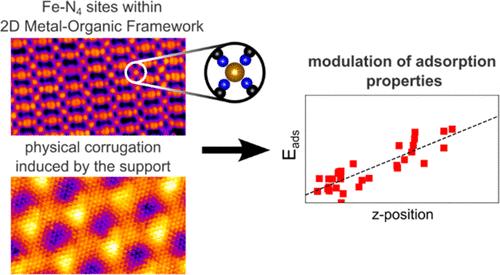相同的Fe-N4位点具有不同的反应性:阐明支撑曲率的影响
IF 8.2
2区 材料科学
Q1 MATERIALS SCIENCE, MULTIDISCIPLINARY
引用次数: 0
摘要
详细的原子尺度理解是合理设计下一代单原子催化剂的重要前提。然而,在普通sac上实现系统研究所需的sub-ångström精度是具有挑战性的。在这里,我们提出了一个具有Fe-N4单原子位的二维(2D)金属有机系统,其中金属有机结构通过惰性石墨烯/Ir(111)载体的0.4 Å波纹来调制。利用扫描隧道显微镜和密度泛函理论,我们发现支撑波纹显著影响了体系的反应性,因为支撑“山谷”上方的位点与TCNQ(四氰喹诺二甲烷)的结合明显强于“山丘”上方的位点。TCNQ的实验温度稳定性变化超过60°C,而计算表明,TCNQ在波纹石墨烯单元电池不同区域上方的Fe-N4位点上的吸附能变化超过0.3 eV。这种效应的来源是位阻,当大分子与邻近的单原子催化剂位点相互作用或多个反应物在这些位点上共吸附时,位阻就会起作用。我们的工作表明,这种影响可以定量研究使用模型SAC系统支持的化学惰性和物理波纹支撑。本文章由计算机程序翻译,如有差异,请以英文原文为准。

Identical Fe–N4 Sites with Different Reactivity: Elucidating the Effect of Support Curvature
Detailed atomic-scale understanding is a crucial prerequisite for rational design of next-generation single-atom catalysts (SACs). However, the sub-ångström precision needed for systematic studies is challenging to achieve on common SACs. Here, we present a two-dimensional (2D) metal–organic system featuring Fe–N4 single-atom sites, where the metal–organic structure is modulated by 0.4 Å corrugation of an inert graphene/Ir(111) support. Using scanning tunneling microscopy and density functional theory, we show that the support corrugation significantly affects the reactivity of the system, as the sites above the support “valleys” bind TCNQ (tetracyanoquinodimethane) significantly stronger than the sites above the “hills”. The experimental temperature stability of TCNQ varies by more than 60 °C, while computations indicate more than 0.3 eV variation of TCNQ adsorption energy across the Fe–N4 sites placed atop different regions of the corrugated graphene unit cell. The origin of this effect is steric hindrance, which plays a role whenever large molecules interact with neighboring single-atom catalyst sites or when multiple reactants coadsorb on such sites. Our work demonstrates that such effects can be quantitatively studied using model SAC systems supported on chemically inert and physically corrugated supports.
求助全文
通过发布文献求助,成功后即可免费获取论文全文。
去求助
来源期刊

ACS Applied Materials & Interfaces
工程技术-材料科学:综合
CiteScore
16.00
自引率
6.30%
发文量
4978
审稿时长
1.8 months
期刊介绍:
ACS Applied Materials & Interfaces is a leading interdisciplinary journal that brings together chemists, engineers, physicists, and biologists to explore the development and utilization of newly-discovered materials and interfacial processes for specific applications. Our journal has experienced remarkable growth since its establishment in 2009, both in terms of the number of articles published and the impact of the research showcased. We are proud to foster a truly global community, with the majority of published articles originating from outside the United States, reflecting the rapid growth of applied research worldwide.
 求助内容:
求助内容: 应助结果提醒方式:
应助结果提醒方式:


